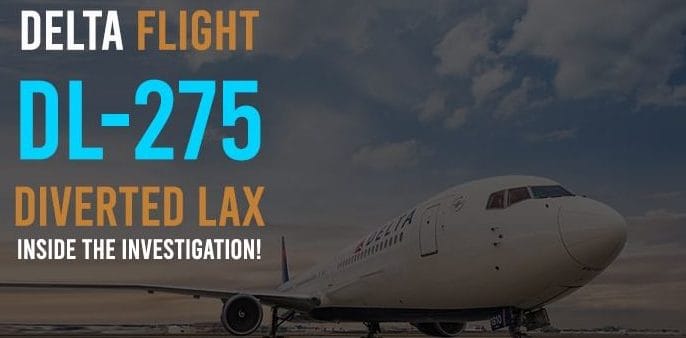For passengers aboard Delta Flight DL275, a routine transpacific journey quickly turned into a tense experience when the aircraft made an unexpected emergency diversion to Los Angeles (LAX). The Delta DL275 diversion LAX incident sparked curiosity across aviation circles, raising questions about what triggered the sudden landing and how the crew managed the unfolding situation.
This article takes a deep dive into the DL275 emergency landing Los Angeles, exploring every key detail — from the cabin pressure issue to the technical malfunction, passenger reactions, and what Delta Air Lines did next.
A Routine Flight Turned Emergency
Flight DL275, operated by Delta Air Lines, was scheduled to fly from Tokyo’s Haneda Airport to Los Angeles International Airport — a long transpacific route that usually runs smoothly. However, mid-flight, pilots noticed warning indicators pointing to a DL275 pressurisation alert, suggesting a possible issue with the aircraft’s cabin pressure system.
The DL275 flight status emergency was declared shortly after, prompting air traffic control to clear a priority path for the aircraft to safely land at LAX.
DL275 Cabin Pressure Issue: The Suspected Cause
According to initial reports, the cause of the Delta Airlines Airbus diversion DL275 was likely a cabin pressure irregularity. Cabin pressure issues can arise from sensor faults, valve malfunctions, or leaks in the fuselage system.
What the Pilots Detected:
- A warning message about inconsistent cabin altitude.
- A drop in pressure levels that triggered a DL275 pressurisation alert.
- Automatic adjustments in oxygen flow to stabilize the cabin environment.
The DL 275 cabin pressure issue led the flight crew to prioritize passenger safety, initiating descent protocols and preparing for a potential emergency diversion DL275 LAX.
Quick Action by the Crew Saved the Day
Delta’s highly trained pilots and crew followed every mid-flight emergency procedure flawlessly. Within minutes of identifying the issue, they declared a code squawk 7700 — the universal emergency signal — alerting controllers to the unfolding situation.
The DL275 forced landing alternate airport was approved, and the aircraft rerouted to Los Angeles. Passengers reported a steady but noticeable descent, with the crew remaining calm and communicative throughout.
“The captain’s voice came over the intercom — very calm, very professional. He said we’d be landing earlier than expected due to a technical issue,” said one passenger after landing.
Safe Landing at Los Angeles International Airport
The DL275 emergency landing Los Angeles occurred without any injuries or panic. Emergency response teams at LAX were on standby as the aircraft landed smoothly on Runway 25L. Fire and rescue units inspected the plane upon arrival — a standard safety protocol for any aviation emergency.
After taxiing safely to the gate, passengers disembarked while engineers and technicians began assessing the DL275 technical malfunction.
Delta’s Immediate Response and Passenger Care
Following the incident, Delta Air Lines released a brief statement confirming the emergency diversion DL275 LAX and emphasizing passenger safety as their top priority. The airline quickly provided assistance to all passengers affected by the diversion.
Support Provided:
- Free meal and hotel vouchers for delayed passengers.
- Delta DL275 passenger rebooking on alternative flights.
- Ground transportation and real-time updates via mobile notifications.
Passengers praised the airline’s transparent communication and the crew’s professionalism during the ordeal.
The Technical Malfunction: What Investigators Found
While the full report from Delta’s maintenance division is still pending, early assessments suggest that the DL275 technical malfunction might have been linked to a faulty cabin pressure sensor.
Delta’s engineers grounded the aircraft immediately for full diagnostics and DL275 aircraft maintenance after diversion. This process involves testing cabin valves, inspecting fuselage seals, and verifying the environmental control system to ensure the aircraft is safe for future flights.
Aviation Safety Experts React
Aviation analysts described the DL275 incident as a textbook example of how emergency procedures should be handled. The crew’s quick decision-making prevented the situation from escalating.
“Declaring a diversion early is always the safest choice,” said aviation expert James Holtz. “Delta’s pilots made the right call by opting for a transpacific diversion before the issue worsened.”
Such incidents highlight the importance of constant aviation safety vigilance, pre-flight inspections, and robust training for in-flight emergencies.
Lessons from the DL275 Diversion
Every aviation event offers lessons that strengthen future safety standards. In the case of Delta DL275, the combination of human skill and advanced aircraft systems ensured that a potentially serious issue ended safely.
Key Takeaways:
- Early detection of pressure irregularities saves time and lives.
- Effective mid-flight emergency procedures are essential.
- Constant pilot training and communication protocols make all the difference.
- Ground response teams at airports like LAX play a critical support role.
The Passenger Experience During DL275 Emergency
Although the event was unsettling, passengers noted that the cabin crew’s calm and composure reassured everyone onboard.
“The flight attendants were incredible. They checked on everyone and explained what was happening without causing panic,” shared another traveler.
Such professionalism turned a stressful DL275 flight status emergency into a controlled, safe experience that reflects Delta’s commitment to passenger well-being.
Delta Airlines’ Official Statement
Delta Air Lines confirmed the event shortly after landing:
“Flight DL275 from Tokyo to Los Angeles diverted to LAX as a precaution due to a possible pressurization issue. The aircraft landed safely, and customers were rebooked on later flights. We apologize for the inconvenience and appreciate our crew’s professionalism.”
The airline emphasized that the aircraft would undergo comprehensive maintenance before returning to service, ensuring the highest aviation safety standards.
Frequently Asked Questions (FAQs)
1. Why was Delta Flight DL275 diverted to LAX?
The Delta DL275 diversion LAX occurred because of a suspected cabin pressure issue, prompting an emergency landing as a precautionary measure.
2. Was anyone injured during the DL275 emergency landing?
No, all passengers and crew members were safe. The DL275 mid-flight emergency procedure ensured everyone’s well-being.
3. What is a “code squawk 7700”?
It’s the universal emergency code used by pilots to alert air traffic control of an in-flight emergency, such as the one declared during the Delta Airlines flight DL275 code squawk.
4. How did Delta handle the affected passengers?
The airline provided passenger re-booking, hotel stays, and food vouchers, along with updates on rescheduled flights.
5. What caused the DL275 technical malfunction?
While investigations continue, early signs point to a sensor fault in the cabin pressure system, leading to the pressurisation alert mid-flight.
6. How common are such emergency diversions?
They’re rare but not unusual. Most are precautionary — like the DL275 incident — ensuring maximum passenger safety at all times.
Final Thoughts
The Delta Flight DL275 diverted to LAX story stands as a reminder of aviation’s strict safety culture and the importance of human expertise in critical moments. While a technical malfunction interrupted a transpacific journey, it also showcased Delta’s commitment to swift, safe, and professional crisis management.
From pilots to passengers, everyone aboard DL275 witnessed how modern aviation blends technology and training to protect lives — even when the unexpected happens miles above the Pacific Ocean.




Leave a Reply